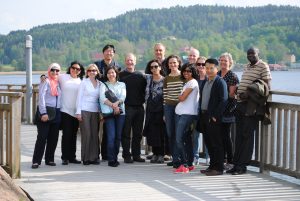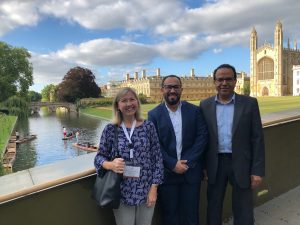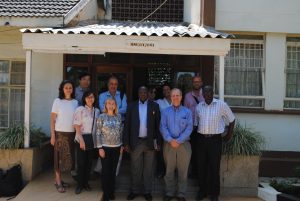As part of the Center for Child and Family Policy's 25th Anniversary celebration, we are honoring faculty, researchers, and staff who have contributed to the Center's work, culture, and impact.
Jennifer Lansford serves as the Director of the Center for Child and Family Policy. Read on to learn more about how she got involved with CCFP, the travels her research has taken her on, and the eclectic book club she is part of.
_____________________________________

I had been an undergraduate at Duke, and when I was in my final year of graduate school at the University of Michigan looking into postdoctoral opportunities, I was excited about the possibility of working with Ken Dodge at CCFP, which he had just recently launched. I was especially drawn to the chance to work in a place that prioritized applying research findings to improve the well-being of children and families.
After completing your postdoctoral fellowship, you stayed with CCFP. What were some of the early projects you worked on at the Center?
When I first started at the Center, I worked primarily on the Child Development Project, a longitudinal study of children’s development that began in 1987 with recruitment of kindergarteners in Nashville and Knoxville, TN and Bloomington, IN. Those original children were followed to age 34, making it possible to understand how a wide range of experiences during childhood and adolescence are related to social relationships, mental health, problematic and adaptive behaviors, employment, and more into adulthood.
Early on in your career you launched the Parenting Across Cultures (PAC) longitudinal study which is now in its 17th year. How did you get the idea for this project?
When I was an undergraduate at Duke, I majored in both psychology and cultural anthropology, so my interest in culture goes back many years. When we launched Parenting Across Cultures, there were several media reports of immigrant parents in a number of countries around the world engaging in parenting practices that were accepted in their home country but were considered problematic or even illegal in their country of destination. For example, all forms of corporal punishment, including spanking, have been against the law in Sweden since 1979, and there were reports of American immigrant parents in Sweden being approached by their children’s teachers to discuss this problematic behavior if they were spanking. These reports sparked my interest in better understanding how cultural contexts shape parenting behaviors and child development, including whether the ways in which parenting affects child development may vary depending on norms in different cultural groups.

In many ways, parenting and child development are similar across cultures, even cultures that differ in important ways. For example, even in cultural groups that emphasize interconnectedness, when children move into adolescence, they make increasing bids for autonomy from their parents, and parents decrease in their assertion of control over time. We do also find interesting cultural differences. For example, when parents have expectations or behave in ways that are widely accepted within a cultural group, these expectations and behaviors are related to more positive child outcomes than when parents have expectations or behave in ways that are not widely accepted by their cultural group. Last year, Ella Davis, a Duke undergraduate, interviewed me about the PAC study if you’d like to read more.
The PAC project has taken you on many adventures around the globe. Please share a memorable story from your PAC travels.
Some of my favorite memories from PAC travels are from visits we have been able to make to the homes of some of the families who have participated in PAC for many years. Families in Kenya and the Philippines were particularly welcoming to our research team, and having the opportunity to talk with these families in their homes was a meaningful way to understand first-hand many of the cultural differences and similarities we study.

In addition to PAC, you’ve worked on a number of other projects. What’s one way you’ve seen your research impact policy at a local, state, or federal level?
Last summer, several of us at the Center worked on a series of reports focused on four “megatrends” identified by the United Nations related to families and (1) climate change, (2) technology, (3) demographic shifts, and (4) urbanization and migration. Each of these reports focused not only on how each megatrend is affecting families, but also made policy recommendations to support families in each of these areas. We had the chance to present key findings from these reports last fall to a global audience from ministries of health, ministries of education, and other government agencies focused on families, as well as at the United Nations this spring.
If you had to choose just one, what is a takeaway from your research that you would want to share?
I would want to stress to parents and other caregivers the importance of working to make children feel loved and accepted. Feeling loved and accepted by their parents is one of the best predictors of children’s mental health, behavioral adjustment, and future positive social relationships.

I have especially enjoyed working with different teams in the Center beyond my own research groups. It has been great fun to work with the administrative team on planning and executing special events, including our signature events like talks in the Sulzberger Distinguished Lecture Series, as well as trying new ideas, like the screening of the documentary film Inheritance. I’ve also really enjoyed having the opportunity to strategize with our Center researchers about our vision for the next twenty-five years.
What’s something people might not know about you?
My husband and I became empty nesters this year. It’s quiet at home now with just our dog and two cats. Our daughter graduated from college in May, and our son just finished his first year of college.
How do you enjoy spending your free time?
I love to read and am part of a book club that has pretty eclectic tastes. We read fiction of every variety as well as non-fiction. I just finished reading Playground by Richard Powers and will start Code Name Hélène by Ariel Lawhon next.
What is your favorite children’s book and why?
It’s hard to pick just one! I might go with Knuffle Bunny by Mo Willems, both for the funny, relatable story and the wonderful combination of photos with illustrations.

